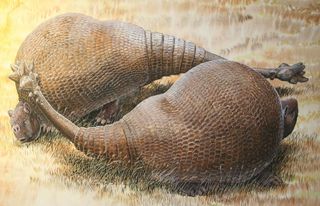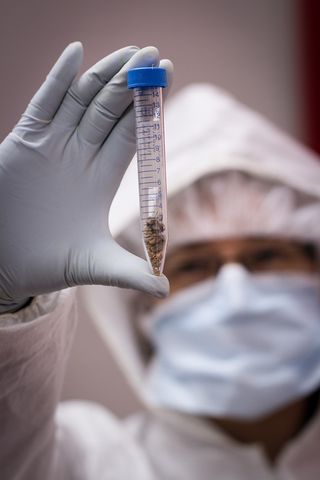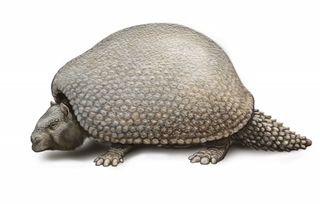Volkswagen-Size Armored Mammal Is Armadillo Ancestor

A new genetic analysis of the glyptodont, an ancient armored creature the size of a Volkswagen Beetle, reveals that it's closely related to the modern-day armadillo.
Glyptodonts roamed the Earth for millions of years until they went extinct during the last ice age, about 10,000 years ago. The animal's clublike armored tail, enormous size and remarkable bony shell have captivated many since Charles Darwin collected the first known specimens in the early 1830s. Though the glyptodont looked like a giant armadillo, scientists weren't sure how it fit into the armadillo family tree until now, the researchers said.
"The data sheds light on the familial relations of an enigmatic creature that has fascinated many but was always shrouded in mystery," study researcher Hendrik Poinar, an evolutionary geneticist and physical anthropologist, said in a statement. "Was the glyptodont a gigantic armadillo or weird offshoot with a fused bony exoskeleton?" [10 Extinct Giants That Once Roamed North America]

Glyptodonts are part of the mammal group Xenarthra, which includes anteaters, tree sloths, extinct ground sloths, extinct pampatheres (a small armadillolike creature) and armadillos, but its relationship to these animals had eluded scientists.
Now, a genetic analysis shows that the glyptodont is nestled deeply within the armadillo family and should be treated like a close relative, the researchers said.
"Glyptodonts, in fact, represent an extinct lineage that likely originated about 35 million years ago within the armadillo [diversification]," said Poinar, who is director of the McMaster Ancient DNA Center at McMaster University in Canada.
Poinar worked with an international team of scientists to collect glyptodont specimens; they used ancient DNA-extraction techniques on one specimen — an approximately 12,000-year-old bony shell of a Doedicurus, one of the largest glyptodonts on record.
Sign up for the Live Science daily newsletter now
Get the world’s most fascinating discoveries delivered straight to your inbox.
An analysis of the specimen, found in Argentina, allowed them to extract and sequence the mitochondrial DNA (genetic data passed down through the maternal line). Then, they compared it with the mitochondrial DNA of other living mammals in the Xenarthra group.

"Ancient DNA has the potential to solve a number of questions such as phylogenetic position — or the evolutionary relationship — of extinct mammals, but it is often extremely difficult to obtain usable DNA from fossil specimens," Poinar said. "In this particular case, we used a technical trick to fish out DNA fragments and reconstruct the mitochondrial genome."
An additional analysis suggested that the last common ancestor shared by the glyptodont and modern armadillo weighed just 13 lbs. (6 kilograms), showing that the glyptodont grew by leaps and bounds compared with its ancestor. The fossil record supports this idea, since glyptodonts appear to have once weighed about 176 lbs. (80 kg) before they evolved into creatures weighing about 4,400 lbs. (2,000 kg) during the Pleistocene, the period before the last ice age.
The study was published online Feb. 22 in the journal Current Biology.
Follow Laura Geggel on Twitter @LauraGeggel. Follow Live Science @livescience, Facebook & Google+. Original article on Live Science.

Laura is the archaeology and Life's Little Mysteries editor at Live Science. She also reports on general science, including paleontology. Her work has appeared in The New York Times, Scholastic, Popular Science and Spectrum, a site on autism research. She has won multiple awards from the Society of Professional Journalists and the Washington Newspaper Publishers Association for her reporting at a weekly newspaper near Seattle. Laura holds a bachelor's degree in English literature and psychology from Washington University in St. Louis and a master's degree in science writing from NYU.
Most Popular


